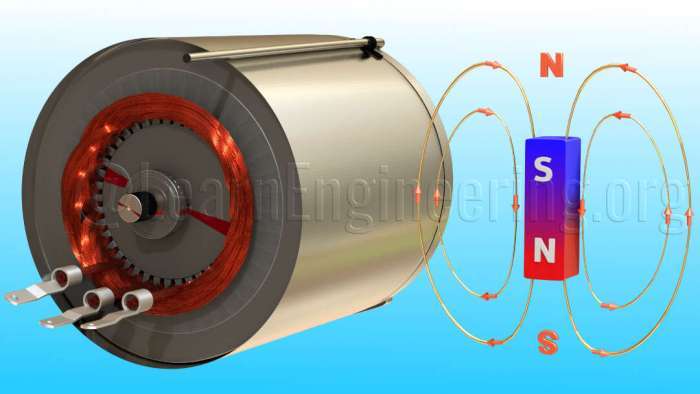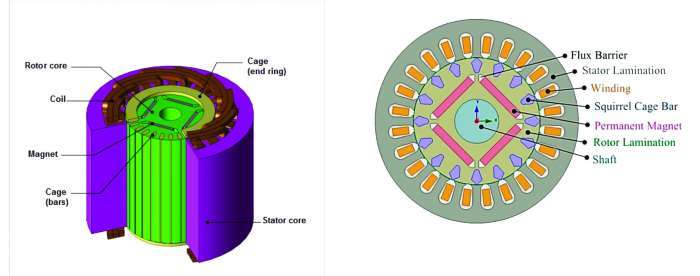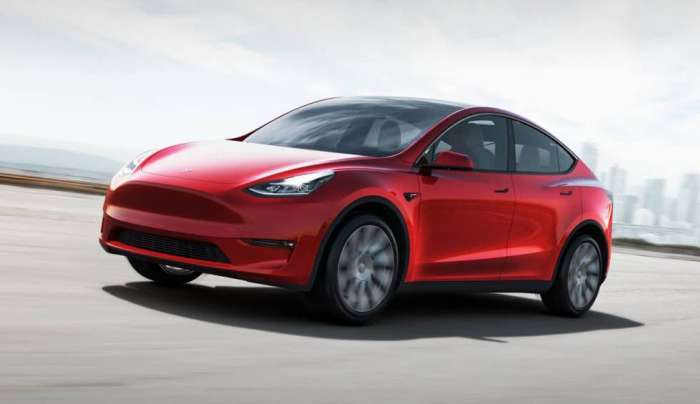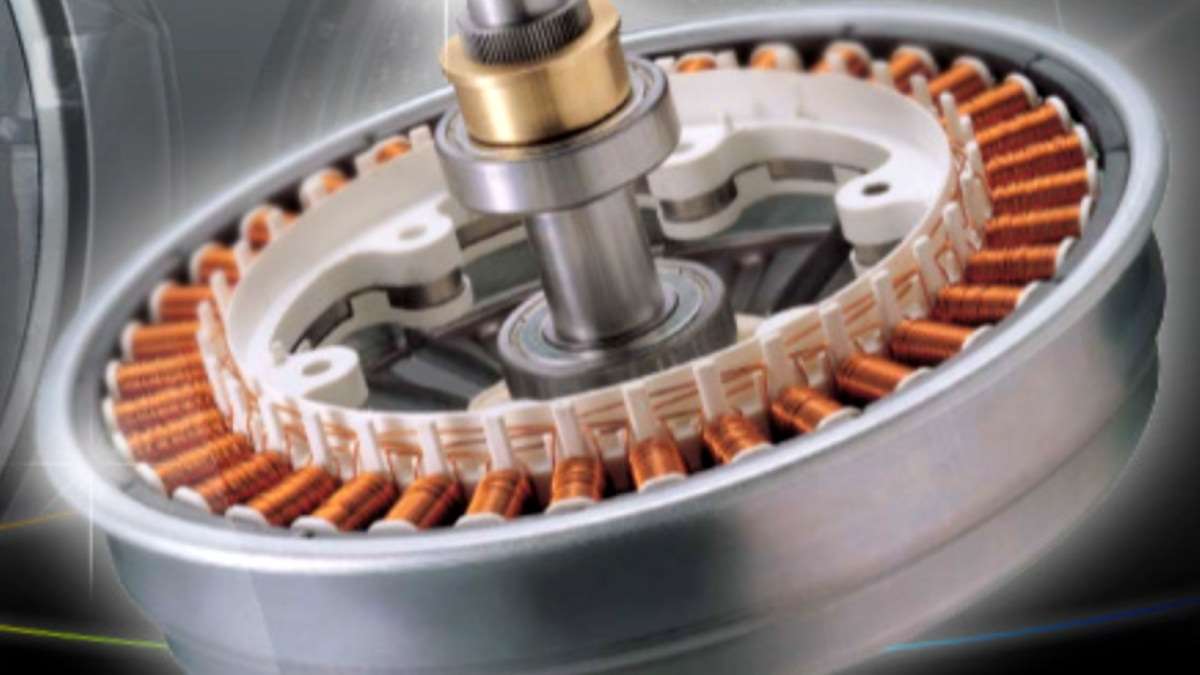As with the Model 3 it uses a synchronous motor for the rear wheels, which are the main drive wheels, and an induction motor for the front wheels, which are the secondary drive wheels, but the rotor conductors of the induction motor are made of cast aluminum, a first for Tesla.
But what exactly are induction and synchronous motors? The first fundamental property on which electric cars differ from internal combustion engine (ICE) cars is the motor. The way a regular four stroke engine works is as follows:
1. On the first stroke, gasoline is injected into a chamber by opening a valve that is then closed again.
2. On the second stroke, the cylinder moves upwards and the gasoline is compressed.
3. On the third stroke the energy in the fuel is harvested by igniting it. The resulting explosion drives the cylinder down and that produces a rotating motion. This is comparable to a bicycle, where pushing down the pedal moves the bicycle forwards.
4. On the fourth and final stroke, the energy burned is emitted.
This is basically the modern gasoline engine and it was invented 150 years ago.
Now, a simple electric motor works as follows:
1. We take a coil of wire and make electricity flow through it, so it creates its own magnetic field. It has become a magnet.
2. We place this magnetic coil between two magnets, so one side of the coil will be pushed up and the other side will be pushed down.
3. This makes the coil turn until it is vertical. At that moment we quickly change the polarity.
4. The effect is rotary motion and what we get here is a simplified direct current motor in action.

A very quick comparison between electric motors and heat engines:
Heat engine Electric Motor Electric motor is...
1-3 kW/kg - 3-10 kW/kg - 3x more powerful
0.4 kW/L - 13.6 kW/L - 40x smaller
5-30% efficient - 93-96% efficient -3-20x more efficient
Many moving parts - One moving part - Maintenance free
There are only three types of motors that are being used in EVs today: the Induction motor, the Permanent magnet motor and the Synchronous reluctance motor.
Let’s start with the simple, classic brushed DC motor. This motor has a stator and a rotor with an electric coil in it. When this coil is connected with the battery, producing a direct current, the coil produces a magnetic field which causes the rotor to rotate to have the poles face the opposite poles of the permanent magnets in the stator. To keep this momentum, the polarity of the coils is switched.

The AC induction motor (invented by Nikola Tesla himself) needs no permanent magnets. Instead the magnetic field is produced by a current that flows through the windings in the housing or stator. Now if you connect the stator to an alternating current, this means the magnetic field in the stator will also alternate. If a three phase AC input is used, a so called rotating magnetic field or RMF is produced. The magnetic field from the stator will induce a voltage and current in the windings of the rotor. That’s why it’s called the induction motor. This in turn leads to the rotor producing its own magnetic field, and this magnetic field will make the rotor turn so as to align itself with the magnetic field from the stator. The rotor will follow this rotating magnetic field in the stator, without the need for a commutator with brushes.
Now, a brief explanation of the permanent magnet motor would be: if we construct a rotor with permanent magnets, we no longer need to induce a magnetic field in the rotor. This avoids losses and heat development in the rotor. Because of all this, permanent magnet motors are currently the smallest and lightest electric motors you can buy. Because the rotor is already magnetized it is always in sync with the rotating magnetic field. That’s why permanent magnet motors are also classified as synchronous motors.

The synchronous reluctance motor has only recently been developed and seems to have the best of both worlds. It has a rotor that contains metal that is formed in such a way that it wants to align itself naturally to the surrounding magnetic field. This means it doesn’t need to produce its own electric field through induced currents, like the induction motor, which means less losses. Finally, it doesn’t need permanent magnets which makes it much cheaper than a permanent magnet motor.
The Powertrain of a Tesla Model Y uses a Permanent Magnet Synchronous Reluctance Motor, that combined with a 75 kWh lithium ion battery easily produces an electric range of 303 miles (488 km) for the Performance model; (EPA-rated) 326 miles (525 km) for the Long Range AWD (EPA-rated) and 244 miles (393 km) for the Standard Range model (EPA-rated). Tesla's specific innovation is the segmented magnets (four parts instead of the more typical single solid magnet). According to ´Learn Engineering´, it helps to reduce the eddy currents and lowers the risk of magnets overheating. Here is a very interesting explanation from a YouTube channel, which explains very well the nuances of the technology: https://www.youtube.com/watch?v=esUb7Zy5Oio

As I mentioned in many articles before, it is easy to understand why the Tesla Model Y is way ahead of the competition with its cutting edge technology, and why it would take any ICE vehicle manufacturer a lot of time, research and effort to get where Tesla is right now, in 2021.
Nico Caballero is the VP of Finance of Cogency Power, specializing in solar energy. He also holds a Diploma in Electric Cars from Delft University of Technology in the Netherlands, and enjoys doing research about Tesla and EV batteries. He can be reached at @NicoTorqueNews on Twitter. Nico covers Tesla and electric vehicle latest happenings at Torque News.






Comments
I see at least two factual
Permalink
I see at least two factual errors in here:
Synchronous Reluctance Machines in its pure form is not used in any production car today.
Almost all cars use IPMs, a combination of Syn. Reluctance Machines and Permanent Magnet Synchronous Machine.
Tesla is not alone with segmented magnets, almost all EVs use that feature in the rotor.
Also, you forgot to mention the Externally Excited Synchronous Machine, which is magnet free, and getting more popular ad an alternative.
Best, Stefan Skoog
PhD, Expert in EV technology
You are right, Stefan, thank
Permalink
You are right, Stefan, thank you for the heads up and comments, will be taken into account.